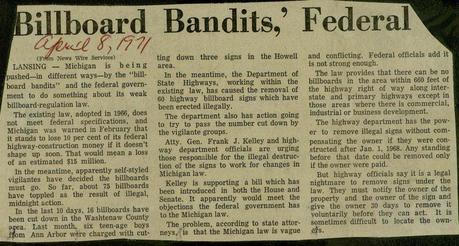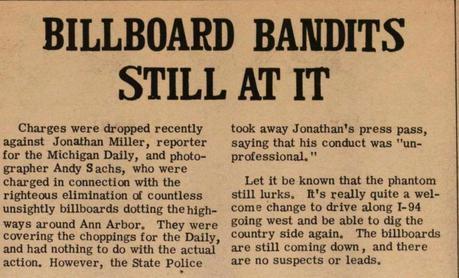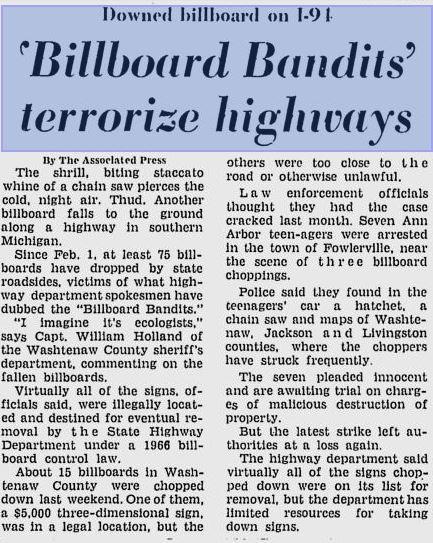 by Russ McSpadden / Earth First! News
by Russ McSpadden / Earth First! News
“The shrill, biting staccato whine of a chain saw pierces the cold, night air. Thud. Another billboard falls to the ground along a highway in southern Michigan.” –Michigan Daily, April 7, 1971
During the early 1970s, Michigan’s Billboard Bandits successfully toppled at least 167 billboards during late night raids, restoring, as Howard Zinn notes in Postwar America, “the quiet beauty of central Michigan.”
In the annals of direct action, the Bandits, too often overlooked, stand out as one of the earliest examples, along with Arizona’s Ecoraiders, of deliberate and successful ecotage in the U.S.
And like many sabotage histories, the details are foggy.
“I imagine it’s ecologists” Capt. William Holland of the Washtenaw County Sheriff department told the Associated Press in 1971.
In early April of that year, after some 75 billboards had already been toppled, law enforcement officials believed they had solved the case after they arrested several Ann Arbor high school students near the scene of three billboard attacks. According to Time Magazine “the boys readily admitted that they were the billboard bandits.” The suspected Bandits included “the president of the senior class at Huron High School, a member of the senior executive board, a member of the student council and a debater who most recently distinguished himself by his analysis of Government anti-pollution programs.”
According to the Michigan Daily, police found “in the teenagers’ car a hatchet, a chain saw and maps of Washtenaw, Jackons and Livingston counties, where the Bandits have struck frequently.” At their hearing, however, the boys “pleaded innocent.”
And the destruction of billboards did not stop with the arrest of these “excellent students.”
New reports came in, some described a Bandit, a lone wolf, lurking Michigan’s Interstate 96 and billboards continued to come down.
Police officers also pressed charges on journalists, including a reporter and photographer for the Michigan Daily, who were covering the actions. State Police took away the reporter’s “press pass, saying that his conduct was ‘unprofessional’” the Anne Arbor Sun reported.
In that same article, dated a month after the arrest of the Ann Arbor students, a rather sympathetic journalist states “Let it be known that the phantom still lurks. It’s really quite a welcome change to drive along I-94 going west and be able to dig the country side again. The billboards are still coming down, and there are no suspects or leads.”
It’s unclear when the Billboard Bandits ended their campaign. State and Federal officials stepped up their efforts to control billboard construction along Michigan’s highways and increased their enforcement of illegal billboards, actually dismantling hundreds of billboards, perhaps making covert action obsolete in the minds of some saboteurs.
Were the Bandits an organized cell or a zeitgeist, a community outrage given voice through copycat actions? It’s possible that there were many diverse Bandits which knew nothing of each other except for a common passion for action against the encroachment of commercial propaganda along the edges of Michigan’s wilds. Whoever they were, replication of their actions grew through the spread of media reports, which placed the stories into homes across the state, sparking more action.
Let’s keep stories of resistance and action alive.

Ann Arbor News, April 8, 1971

Ann Arbor Sun, May 7, 1971

Michigan Daily, April 7, 1971

